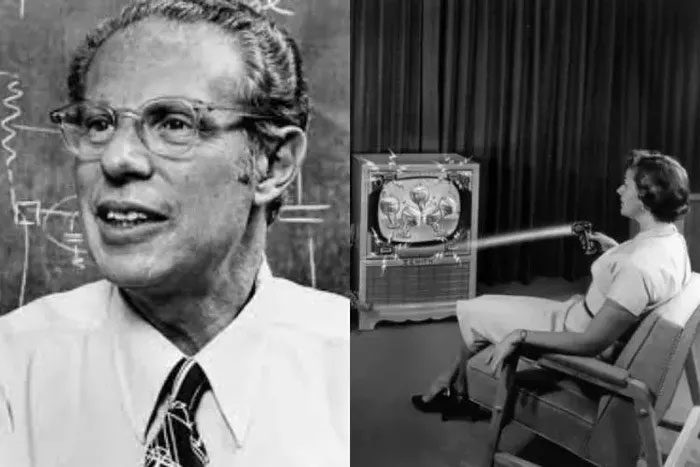He is best known by the nickname “Father of the TV Remote Control.”
Robert Adler was born in Vienna, Austria on December 4, 1913. He was a talented physicist with a passion for nature, literature, and classical music. He successfully defended his doctoral thesis in physics at the University of Vienna in 1937, at just 24 years old. Shortly after, he immigrated to the United States and worked in the research department of Zenith Electronics Corporation in Western Chicago.
During World War II, Adler specialized in researching military communication devices, including high-frequency oscillators and electromechanical filters for aircraft radios.

Robert Adler (1913-2007). (Photo: Wikipedia)
Adler consistently sought broader applications for existing technologies. For instance, in the 1960s, he utilized his wartime research to develop a frequency filter for color TVs based on surface acoustic wave (SAW) technology. Today, acoustic wave technology plays a crucial role in both TV screens and touch computer displays.
After the war, Adler focused on television technology. One of his earliest inventions was the control-gated vacuum tube, which effectively eliminated audio noise in television receivers and reduced operational costs. He and his colleagues also developed a special synchronization circuit that improved signal reception in the fringe areas of broadcast stations. However, his most significant achievement was the wireless remote control device.
The desire to control machinery remotely has existed for a long time. As early as the late 1800s, the genius inventor Nikola Tesla patented a variant of remote control technology, which he claimed could operate a ship from the shore.
In the early 1950s, Eugene F. McDonald Jr., the founder of Zenith Electronics Corporation, believed that what television viewers desired most was the ability to skip annoying product advertisements by changing the channel, muting the sound, or both.
Robert Adler invented the TV remote control known as Space Command, which operated on ultrasonic waves in 1956 and was sold alongside nine million TVs before infrared remote control technology emerged in the early 1980s.
Based on McDonald Jr.’s insights, Zenith Electronics produced the first TV remote control called “Lazy Bones.” It could turn the TV on/off and change channels without the viewer having to stand up. However, it was quite bulky due to its wired connection to the TV, posing a tripping hazard for elderly users.
In 1955, Zenith introduced the “Flashmatic”, a wireless remote device that essentially functioned like a flashlight, directing light at light sensors [or photoresistors] located in the corners of the TV cabinet. Besides the light from the remote, these sensors also responded to sunlight.
Although the Flashmatic addressed the previous issue of Lazy Bones by eliminating the wires, it introduced another problem: sunlight could cause the TV to behave erratically.
McDonald Jr. convened researchers for an emergency meeting at Zenith to solve this issue. The solution using radio waves was dismissed, as they could penetrate walls and change the channels of neighbors’ TVs.
Adler’s solution was to have the remote control “communicate” with the TV using sound rather than light – specifically, using ultrasonic waves at frequencies above human hearing. Adler’s remote control was very simple in design. It even did not require batteries. The buttons activated a small hammer that struck one of four lightweight aluminum rods inside the device, similar to a piano key striking a string. The signal receiver in the TV interpreted these high-frequency sounds as commands to change channels, mute/unmute, or power on/off.
In a 2004 interview with the Archive of American Television, Adler recounted that he came up with the solution for the remote control after visiting a steel mill and hearing the piercing sounds of metal bars striking a hard object. He returned to the lab with the idea of using ultrasonic waves, beyond the range of human hearing, to send signals to the receiver in the TV.
Initially, Adler’s sound-based TV remote system known as Space Command raised the price of equipment by about 30%, creating some financial pressure on consumers. However, due to its convenience and utility, this technology quickly gained popularity.

Adler honored as the “Father of the TV Remote Control”.
In the 1960s, Adler improved his system to generate ultrasonic signals using electronic circuits. Over the next twenty years, ultrasonic remote controls gradually became a standard accessory for TVs. Zenith and other companies sold over nine million TVs equipped with the ultrasonic remote control system before infrared control technology emerged in the early 1980s.
Today, remote controls are widely used in the consumer electronics and entertainment industries. Most electronic devices such as TVs, DVD players, air conditioners, and fans come with remote controls.
For his significant contributions, Adler is honored as the “Father of the TV Remote Control”, a seemingly simple device that has transformed and enhanced our experience of enjoying programs on the small screen.
“However, if asked, Adler would not choose the remote control as his favorite invention,” his wife Ingrid shared with the Latimes in 2007. “In fact, he didn’t even spend much time watching TV. He preferred reading books.”
“My husband would often dream at night and suddenly wake up saying, ‘I just solved a problem.’ He was always thinking about science,” Ingrid noted.
In 1963, Adler became Vice President and Director of Research at Zenith Electronics. He served as a technical advisor to the company until 1997.
Adler passed away at the Boise, Idaho nursing home due to heart failure on February 15, 2007, at the age of 93. Throughout his career, he held a total of 180 patents and received numerous prestigious awards, including the Edison Medal from the Institute of Electrical and Electronics Engineers (IEEE) in 1980. He was also a member of the National Academy of Engineering and the American Association for the Advancement of Science (AAAS).


















































